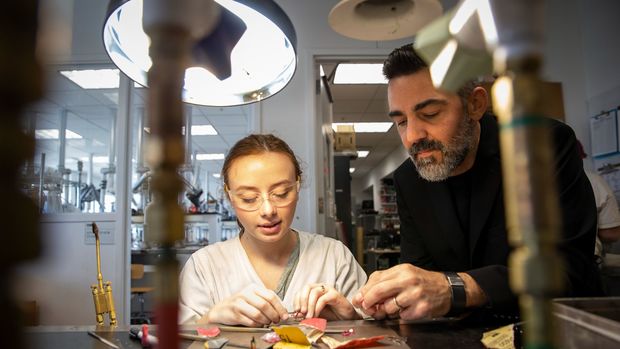Two Tyler Programs Receive STEM Designation

Two programs at the Tyler School of Art and Architecture now have a new designation -- STEM program, which benefits students while studying at Tyler and when they are ready to enter the workforce.
Both the Metals/Jewelry/CAD-CAM (MJCC) program and the Design and Illustration Department underwent reviews with Temple University’s Office of Institutional Research and Assessment to identify new categorizations that reflect greater integration of technology in arts curriculums.
“This new status elevates the program's academic rigor and enhances the educational experience by improving access to cutting-edge technology and expanding research opportunities, thereby enriching the learning environment with the integration of CAD technologies throughout our entire curriculum,” explained Doug Bucci, Assistant Professor and Program Head of MJCC.
For MJCC, the STEM designation recognizes the program’s comprehensive integration of science, technology, engineering and mathematics within the artistic aspects of metalwork and jewelry design.
The MJCC program was previously classified in a way that didn't recognize computer-aided design applications in jewelry production, industrial design, and engineering, a significant portion of the curriculum, Bucci explained.
“The Metals/Jewelry/CAD-CAM program at Tyler has been a pioneer in integrating computer-aided design into jewelry art since 1989,” Bucci said. “Recognized globally for our leadership, we have established ourselves as the premier program in CAD jewelry and metalsmithing, both in academia and industry.”
The MJCC program now has a designation that accurately reflects the incorporation of CAD in various aspects of jewelry manufacturing, including concept drawings, 3D renderings, physics animation, coding, engineering, and 3D printing technologies.
“Our curriculum bridges the gap between virtual and tangible jewelry making, preparing students for diverse career opportunities in the industry,” Bucci said.
Similarly, the Design and Illustration Department felt the need for a classification that better represented its recently revamped degree programs, including two new BFA degrees – Illustration and Emerging Media and UX/UI (User Experience/User Interface), which is slated to launch in fall 2025.
“This encapsulates the forward thinking and technologically based stance at the heart of our BFA and MFA programs,” said Matt Curtius, Associate Professor of Graphic Design. “The new designation aligns with the department’s embrace of technological tools and avenues of communication. Our students learn in an environment that keeps them abreast of a quickly developing design landscape while preparing them to lead the way from an informed perspective.”
MJCC prepares students for careers beyond jewelry studios, in fields such as industrial design, engineering and sciences.
“In the jewelry industry, our graduates occupy prominent roles at esteemed companies such as Tiffany & Co., David Yurman, and Alexis Bittar, leading initiatives in CAD design and manufacturing,” said Bucci. “In the field of industrial design, they bring their expertise to well-known brands like Puma, Crayola, and K’Nex, undertaking significant design and engineering responsibilities.”
Bucci added that MJCC graduates have applied their CAD skills at the new digital lab at Temple University’s Maurice H. Kornberg School of Dentistry, and at Golden Ceramics Dental Lab, utilizing digital and computer-aided technologies in development of dental materials and to support dental procedures.
The STEM designation for both programs will strongly benefit international graduates, because it allows them to remain in the United States and gain professional experiences for up to three years after completing their degree.
“Suffice it to say, this is great news for students studying with us who would then like to establish their professional life and further contribute to the design community here in the states,” Curtius noted.
Bucci agreed: “This extended practical exposure is crucial because it prepares students for highly competitive roles in the jewelry design and manufacturing sectors, enhancing their employability and equipping them with vital hands-on skills in a real-world context.”
Other Tyler programs that have the STEM designation include the bachelor's degrees in Architecture, Facilities Management, Landscape Architecture and Horticulture; and the master's degrees in Architecture and Landscape Architecture.
Read more about how Tyler’s design and illustration and metals/jewelry/CAD-CAM programs prepare their students for STEM careers in Temple Now.